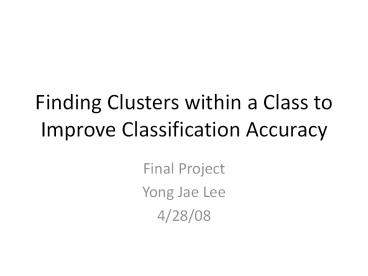Finding Clusters within a Class to Improve Classification Accuracy - PowerPoint PPT Presentation
Title:
Finding Clusters within a Class to Improve Classification Accuracy
Description:
Finding Clusters within a Class to Improve Classification Accuracy. Final ... J. Quinonero-Candela, I. Dagan, B. Magnini, and F. d'Alche-Buc, LNAI 3944, pages ... – PowerPoint PPT presentation
Number of Views:39
Avg rating:3.0/5.0
Title: Finding Clusters within a Class to Improve Classification Accuracy
1
Finding Clusters within a Class to Improve
Classification Accuracy
- Final Project
- Yong Jae Lee
- 4/28/08
2
Objective
- Find Clusters
- Car images
3
Approach
- Object Representation
- Scale Invariant Feature Transform
- (SIFT) Lowe. 2004
- Image to Image Similarity
- Proximity Distribution Kernels Ling et al.
2007 - Clustering
- Normalized Cuts Shi et al. 2001
- Classification
- Support Vector Machines Vapnik et al. 1995
X1 X2 X3 X4
X1 K11 K12 K13 K14
X2 K21 K22 K23 K24
X3 K31 K32 K33 K34
X4 K41 K42 K43 K44
4
Dataset 1
- PASCAL VOC 2005
- 4 categories
- motorbikes, bicycles, people, cars
- Train set
- 214, 114, 84, 272 (684)
- Test set
- 216, 114, 84, 275 (689)
5
Results 1
- Baseline (no-clusters)
- Clusters (k3)
94.9 0 0 5.1
12.3 71.9 5.26 10.5
10.7 11.9 32.1 45.2
2.9 2.6 3.6 90.9
95.4 0 0 4.6
13.2 73.7 3.5 9.7
10.7 11.9 34.5 45.2
2.2 2.2 4.0 91.6
m
m
b
b
true labels
p
p
c
c
m
b
p
c
m
b
p
c
predicted labels
Mean accuracy 81.86
Mean accuracy 82.87
6
Dataset 2
- Caltech-101
- 101 object categories
- 9097 images (30-80 per class)
- 30 images / class
- 15 train, 15 test
- 10 runs cross-validation
7
Results 2
- Baseline (no-clusters)
- mean accuracy 57.42 (1.13)
- Clusters (k3)
- mean accuracy 59.36 (1.05)
8
Future work
- Automatically determine k
- - analyze eigenvalues of the Laplacian of
affinity matrix Ng et al. 2001 - - significant difference between two consecutive
eigenvalues determines how many clusters there
are - Comparison with other classifiers
- - e.g., k-Nearest Neighbor labels are
determined by majority labels of train instances
to the test instance
9
Questions
10
References
- H. Ling and S. Soatto, Proximity Distribution
Kernels for Geometric Context in Category
Recognition, IEEE 11th International Conference
on Computer Vision, pp. 1-8, 2007. - D. Lowe, Distinctive Image Features from
Scale-Invariant Keypoints," International Journal
of Computer Vision, vol. 60, no. 2, pp. 91-110,
2004. - J. Shi and J. Malik, Normalized cuts and image
segmentation," IEEE Transactions on Pattern
Analysis and Machine Intelligence, vol. 22, no.
8, pp. 888-905, 2000. - C. Cortes and V. Vapnik, Support-vector
networks," Machine Learning, vol. 20, no. 3, pp.
273-297, 1995. - M. Everingham, A. Zisserman, C. K. I. Williams,
L. Van Gool, et al. The 2005 PASCAL Visual
Object Classes Challenge, In Machine Learning
Challenges. Evaluating Predictive Uncertainty,
Visual Object Classification, and Recognising
Textual Entailment., eds. J. Quinonero-Candela,
I. Dagan, B. Magnini, and F. d'Alche-Buc, LNAI
3944, pages 117-176, Springer-Verlag, 2006. - A. Ng, M. Jordan and Y. Weiss. On spectral
clustering Analysis and an algorithm In
Advances in Neural Information Processing Systems
14, 2001 - L. Fei-Fei, R. Fergus, and P. Perona. Learning
generative visual models from few training
examples an incremental Bayesian approach tested
on 101 object categories. In Proceedings of the
Workshop on Generative-Model Based Vision.
Washington, DC, June 2004.































